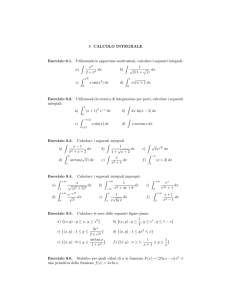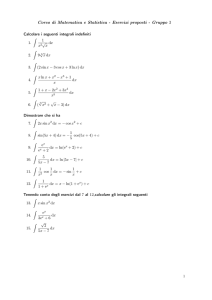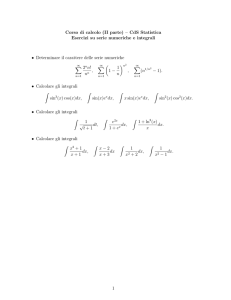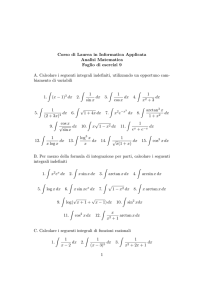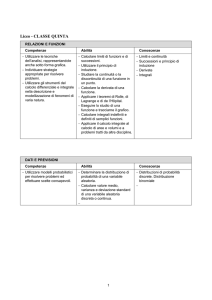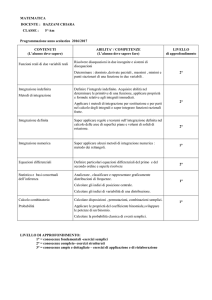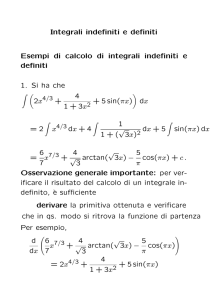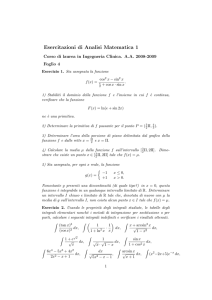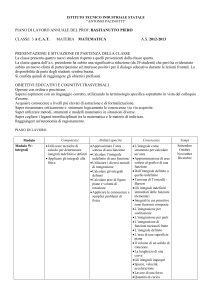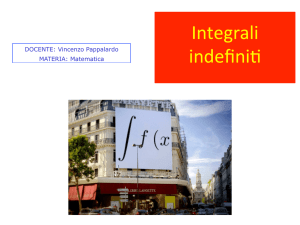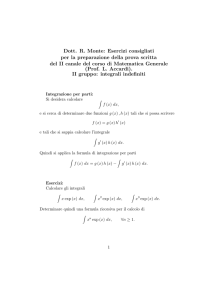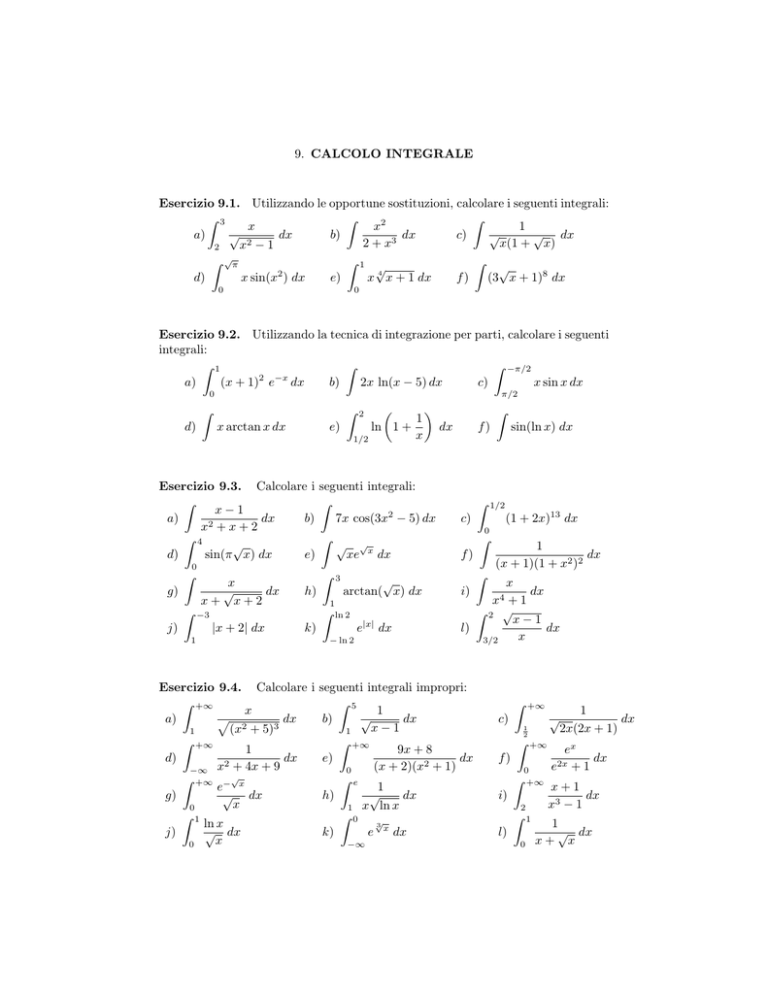
9. CALCOLO INTEGRALE
Esercizio 9.1. Utilizzando le opportune sostituzioni, calcolare i seguenti integrali:
Z 3
Z
Z
x
x2
1
√ dx
√
√
a)
dx
b)
dx
c)
3
2
2+x
x(1 + x)
x −1
2
Z 1
Z √π
Z
√
√
4
2
x sin(x ) dx
e)
x x + 1 dx
d)
f ) (3 x + 1)8 dx
0
0
Esercizio 9.2. Utilizzando la tecnica di integrazione per parti, calcolare i seguenti
integrali:
Z 1
Z
Z −π/2
a)
(x + 1)2 e−x dx
b)
2x ln(x − 5) dx
c)
x sin x dx
0
π/2
Z
d)
Z
x arctan x dx
2
e)
ln 1 +
1/2
1
x
Esercizio 9.3. Calcolare i seguenti integrali:
Z
Z
x−1
dx
b)
7x cos(3x2 − 5) dx
a)
x2 + x + 2
Z 4
Z
√ √x
√
e)
xe dx
d)
sin(π x) dx
Z
dx
f)
sin(ln x) dx
1/2
Z
(1 + 2x)13 dx
c)
0
Z
1
dx
(x + 1)(1 + x2 )2
f)
0
Z
g)
Z
x
√
dx
x+ x+2
1
3
√
arctan( x) dx
Z
i)
Z
ln 2
k)
e|x| dx
Z
2
l)
− ln 2
Esercizio 9.4. Calcolare i seguenti integrali impropri:
Z +∞
Z 5
x
1
p
√
a)
dx
b)
dx
2
3
x
−1
(x + 5)
1
1
Z +∞
Z +∞
1
9x + 8
d)
dx
e)
dx
2 + 4x + 9
x
(x
+
2)(x2 + 1)
−∞
0
Z +∞ −√x
Z e
e
1
√ dx
√
g)
h)
dx
x
0
1 x ln x
Z 1
Z 0 √
ln x
3
√ dx
j)
k)
e x dx
x
0
−∞
x
dx
+1
√
x−1
dx
x
x4
1
−3
|x + 2| dx
j)
Z
h)
3/2
+∞
Z
√
c)
1
2
Z
+∞
f)
Z
0
+∞
i)
2
Z
l)
0
1
1
dx
2x(2x + 1)
ex
dx
+1
e2x
x+1
dx
x3 − 1
1
√ dx
x+ x
Esercizio 9.5.
Calcolare le aree delle seguenti figure piane:
1
a) {(x, y) : y ≤ x, y ≥ x2 }
b) {(x, y) : y ≥ , y ≤ ex , y ≤ 1 − x}
2
3ex
}
d) {(x, y) : 1 ≤ yx3 ≤ x}
c) {(x, y) : 1 ≤ y ≤
1 + e2x
x+1
e) {(x, y) : 0 ≤ y ≤ xe−x }
f ) {(x, y) : x ≥ 2, 0 ≤ y ≤ 3
}
x −1
arctan x
1
}
g) {(x, y) : x ≥ 1, − 2 ≤ y ≤ xe−x }
h) {(x, y) : 0 ≤ y ≤
x
1 + x2
√
1
1
i) {(x, y) : x ≥ 1,
≤y≤ }
j) {(x, y) : −1 ≤ y ≤ x − 1, x + y ≤ 3}
x+1
x
Esercizio 9.6. Stabilire per quali valori di α la funzione F (x) = (2 ln x − α)x2 è
una primitiva della funzione f (x) = 4x ln x.
Esercizio 9.7.
Determinare la primitiva di f (x) = ln(x2 + 1) che vale 7 in x = 1
Esercizio 9.8.
Dimostrare che se f (x) è una funzione continua e pari allora:
Z a
Z a
f (x) dx = 2
f (x) dx
−a
0
per ogni a ≥ 0.
Esercizio 9.9.
Sapendo che f (x) è continua e che l’uguaglianza:
Z x
f (t) dt = x2 (1 + x)
0
vale per ogni x reale, determinare il valore di f (1).
Esercizio 9.10.
Determinare la natura del punto x = 0 per la funzione:
Z x4
F (x) =
ln(1 + t) dt .
x3

